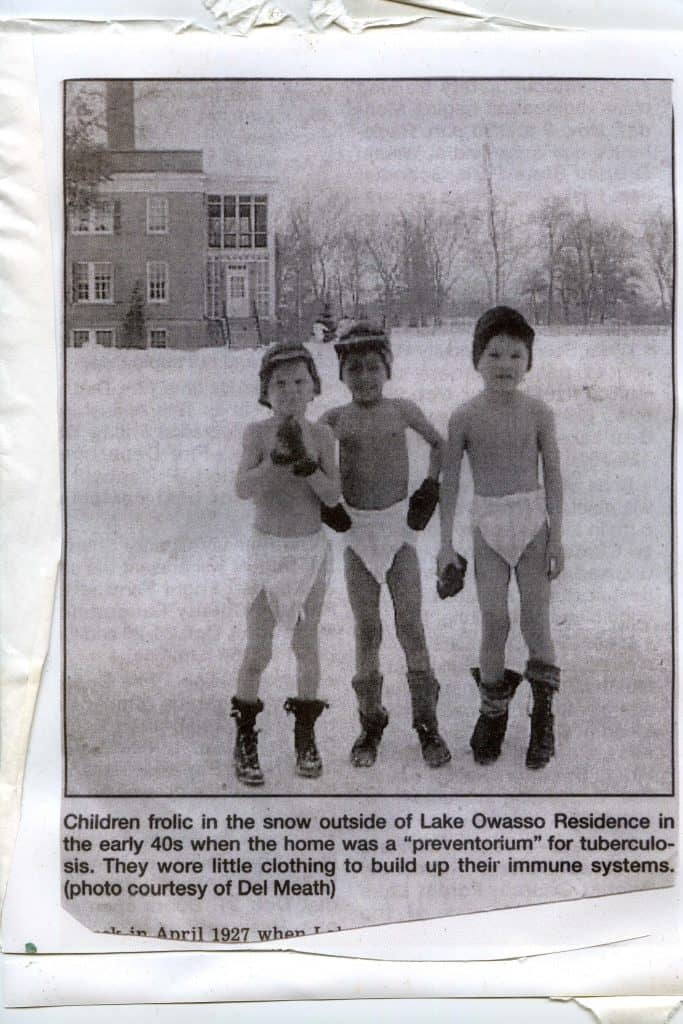
The history behind the Lake Owasso Residence
To look at the history behind the Lake Owasso Residence, one must go back to 1857, which is the year that H. Longstreet Taylor was born. H. Longstreet Taylor completed his medical degree in 1882 when he began his life-long quest to fight Tuberculosis. 1882 also marked the year that a German Physicist – Dr. Robert Koch – discovered the TB bacillus. Dr. Taylor went to Berlin, where he studied with Dr. Koch for two years. In 1893 Dr. Taylor moved from Ashville North Carolina to St. Paul, Minnesota because he believed that cold weather from fresh air and sunshine was essential to finding a cure for TB. Although the deadly effect of TB required the attention of many Minnesota leaders in the 1890’s, it was Dr. Taylor who particularly stood out as he worked tirelessly to stamp out Tuberculosis.
1910
The Cuenca Tuberculosis Sanatorium at the Northeast corner of Lake Owasso (then known as Bass Lake) was opened on the property where the current Lake Owasso Residence now stands. Dr. Taylor was the driving force in opening the Cuenca facility. In 1910, the death rate from tuberculosis in the United States was 147,627. TB was known as the “white death”. Local hospitals refused to admit TB infected patients, for fear of spreading the contagious disease to other patients. Since there was no vaccination for TB at the time, TB Sanatoriums were used to treat TB patients and to isolate TB infected patients from the greater population.
1914
“White Death” was ravaging the city of St. Paul. In response to the spread of TB, Dr. Taylor, with the help of 100 women from St. Paul created a fund raiser called “Tag Day”. The funds from Tag Day were to be used to purchase a piece of property outside the city where tuberculosis endangered children could be treated. A newly found corporation named the “Children’s Preventorium of Ramsey County” was created to administer the effort toward this purchase. The women directed the efforts of another 1,000 women who took to the streets to solicit donations. Those willing to donate had a small red and white tag pinned to their lapel. The Tag Day effort raised $8,000 from area residents coupled with an additional $7,000 from the late James J. Hill for a total of $15,000. The Wilder Foundation was also involved in supporting children that would be housed at the Preventorium. The First National Bank building on the corner of 4th and Minnesota Street served as the headquarters for “Tag Day” efforts. Meanwhile, the Cuenca facility, albeit operating at full capacity with a worthy mission, experienced funding shortages to properly maintain and run the facility. With the proceeds from the Tag Day fund raiser, The “Children’s Preventorium of Ramsey County” chose to purchase the 9-acre site held by the Cuenca Sanatorium for $15,000. (Records indicate the name Lake Owasso by 1914, so apparently the name was changed from Bass Lake sometime after 1910).
1915
Children’s Preventorium of Ramsey County opens where the current Lake Owasso Residence now stands. Still no cure for TB, the Preventorium continued the tradition of the Cuenca Sanatorium to provide healthy diet and ample outdoor activity for patients. Tag Day donors were invited to tour the Preventorium. Transportation to the Preventorium from downtown St. Paul was available via the Soo Line from the Union Depot. The train would pass by the Peoples Coal and Ice Company then located on Lake Owasso just to the south of the Prevntorium.
1943
A successful vaccination for TB is found. Widespread vaccinations begin in following years.
1955
With the cure for TB in hand the need for the Preventorium for TB diminishes. The State of Minnesota converts the Children’s Preventorium buildings to homes for people with developmental disabilities.
1976
Ramsey County Humans Services takes over control of operations, keeping the same basic mission of serving people with developmental disabilities.
1998
Demolition of buildings at the Lake Owasso Residence site begins to make way for new building.
Today
Eight single story residences house 64 residents with disabilities. Each of the 8 residences contains a kitchen, three bathrooms and 8 bedrooms. Lake Owasso staff is committed to maximizing each residents social, physical and developmental potential. Although the mission served at the current Lake Owasso site has changed over the years, it has nearly a 100 year history of providing a valuable community service. Today the Lake Owasso residence is the only County operated facility in the State serving people with developmental disabilities.
Read more
